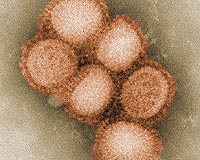| . |  |
. |
Paris (AFP) July 27, 2009 Governments are scrambling to buy up hundreds of millions of doses of swine flu vaccine but health experts warn the poor may lose out as wealthy countries corner strictly limited supplies. The World Health Organisation has unofficially estimated that the world's labs may only be able to produce around 900 million doses for the A(H1N1) strain per year, for a planet that is home to 6.8 billion people. Global pharmaceutical companies are more optimistic about how much of the drug they can produce but, since each potential victim needs two doses, most of the world's population will inevitably miss out. And there are already signs that the wealthiest countries will snap up more than their fair share in the rush to halt the outbreak, while Africa, Asia and Latin American will struggle to secure adequate amounts of vaccine. "The lion's share of these limited supplies will go to wealthy countries. Again we see the advantage of affluence. Again we see access denied by an inability to pay," WHO director Margaret Chan said last week. France, for example, placed a firm order for 94 million doses of vaccine doses and an option for 36 million more. Starting in October, it hopes to be able to protect each and every member of its population of 64 million. The United States has set aside at least a billion dollars to buy vaccine, and Britain hopes to protect at least half of its 60 million population by the start of next year and the other half as soon as possible afterwards. Australia has also ordered enough vaccine for its 21 million population, and as more rich world countries follow suit the world's potential stock of the drug will soon run out, while prices are set to rise. "We expressed our concern about being able to count on the vaccine when it starts going on sale," Argentina's Health Minister Juan Manzur said last week after meeting worried Latin American colleagues. "We have information that much of the production is already reserved." Pharmaceutical firms are racing to increase their capacity to produce an A(H1N1) vaccine, once tests confirm that one has been developed, and hope to begin releasing stocks in late September or early October. But even if they manage to make double the expected 900 million doses per year, this would still fall far short of the amount that would be needed to protect every man, woman and child on the planet from the pandemic. In these circumstances, some countries and independent experts think the best way forward is for authorities to focus on immunising health workers and the most vulnerable patients in order to conserve stocks. The WHO is negotiating with vaccine producers to secure donations or sales at lower prices for developing countries, while richer nations are being asked to donate some of their vaccine stocks. Peter Wutzler, president of the German Association for the Fight Against Viral Disease, said he thought his country had made the right decision in only looking to innoculate around a third of its people. "Vaccine for 30 percent of the population is enough to vaccinate the seven million people in the health sector, another seven million in the public service and risk groups such as pregnant women or children," he told AFP. "Germany took account in its order of the fact that pharmaceutical groups have only a limited capacity. They will not be able to provide the whole world with the vaccine," he warned. Even this more conservative plan, however, will eat up a large chunk of potential global stocks. Berlin ordered 50 million doses for 25 million people and does not rule out ordering more if the situation worsens. "I think it is inappropriate that countries have sparked a competition for the vaccine," said Wutzler. The swine flu virus has spread to almost every country in the world since it was discovered at the end of March. It was declared a global pandemic in June and is thought to have caused at least 800 deaths. While it spreads quickly, the A(H1N1) flu variant is so far not regarded as especially dangerous -- the vast majority of victims survive and the illness responds to treatment from flu remedies such as Tamiflu. Experts warn, however, that the virus might mutate and become more deadly, and that with the onset of the winter flu season in the northern hemisphere might become a major health catastrophe. Share This Article With Planet Earth
Related Links Epidemics on Earth - Bird Flu, HIV/AIDS, Ebola
 Factfile: What is swine flu?
Factfile: What is swine flu?Paris (AFP) July 26, 2009 "Swine flu" is the name commonly given to a new form of flu. From a first known case in Mexico, the outbreak has spread at exceptional speed, prompting the UN's World Health Organisation (WHO) to declare a pandemic on June 11. The official designation is A(H1N1) influenza. ... read more |
|
| The content herein, unless otherwise known to be public domain, are Copyright 1995-2009 - SpaceDaily. AFP and UPI Wire Stories are copyright Agence France-Presse and United Press International. ESA Portal Reports are copyright European Space Agency. All NASA sourced material is public domain. Additional copyrights may apply in whole or part to other bona fide parties. Advertising does not imply endorsement,agreement or approval of any opinions, statements or information provided by SpaceDaily on any Web page published or hosted by SpaceDaily. Privacy Statement |